Emerald Ash Borer in Connecticut
The Latest Map of EAB in CT
Regulations on Movement of Firewood
Firewood Transportation Maps
Managing Emerald Ash Borer in Connecticut
Self Issued Certificate for Transportation of Firewood: On-line Form | Word Form | PDF
The Emerald Ash Borer in Connecticut
Overview
What Is the Emerald Ash Borer?
Why Is EAB a Problem?
Signs and Symptoms of EAB
Efforts to Detect EAB (traps and wasps)
What Is Happening Now that EAB Is Found in Connecticut?
What Should I Be Doing?
Other Sources of Information
Resources for Spreading the Word

Unless otherwise indicated, photos are courtesy of Forestry Images
The Emerald Ash Borer in Connecticut
The emerald ash borer (EAB) was first found in Connecticut during the week of July 16, 2012. Since that first find in Prospect, EAB has been found in most other towns in Connecticut.
DEEP, the CT Agricultural Experiment Station (CAES), USDA APHIS PPQ and the US Forest Service are working together with local partners to slow the spread of the insect and to take steps to minimize its impact. This continues to be a long-term effort on the part of all involved.
Property owners concerned about specific ash trees have options to protect their trees. Very good information on caring for ash trees can be found at www.emeraldashborer.info and in recommendations on the CT Agricultural Experiment Station web site.
Forestland owners should also give careful thought to the management of their woodlands in the face of EAB. The most important recommendation is to not act hastily. There are excellent resources available, including within the forestry program at DEEP. A range of options should be considered before committing to the removal of ash trees or other trees due to this insect pest.
DEEP and CAES will continue to provide direction and updates regarding the emerald ash borer as more becomes known about the extent and intensity of the infestation.
Overview
Invasive, exotic insects are a constant threat to the trees and forests of the state. Over the past century, the state's woodlands and urban forests have been hard hit by the spongy moth, Japanese beetle, and hemlock woolly adelgid, among other pests. More recently, the state has been bracing for the possibility that the Asian longhorned beetle will be found within its borders. In the meantime, another invasive insect has arrived - the emerald ash borer.
What Is the Emerald Ash Borer?
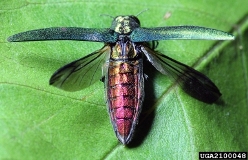
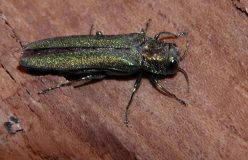
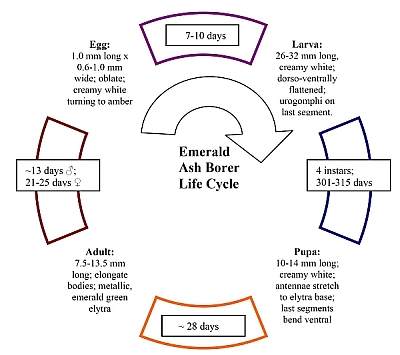
From the USDA Emerald Ash Borer Program Manual
During its life cycle, EAB undergoes a complete metamorphosis. It starts as an egg, becomes a larva (alternatively called a grub), changes to become a pupa and then is an adult. The life cycle of an EAB takes either 1 or 2 years to complete. Adults begin emerging from within ash trees around the middle of June. Emergence continues for about 5 weeks. The female starts laying her eggs on the bark of ash trees about 2 weeks after she emerges. After 7 to 10 days, the eggs hatch and the larvae move into the bark, to begin feeding on the phloem (inner bark) and cambium of the tree. Throughout each of its successive instars (larval growth stages), the larva continues to feed on the phloem and cambium of the tree. The larval stage may last for nearly two years. Before becoming an adult, the insect overwinters as a pre-pupal larva. It then pupates in the spring and emerges as an adult during the summer.
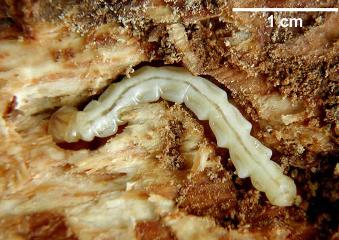
EAB feeds on ash trees almost exclusively. While the larvae feed on the phloem and cambium, the adults feed on leaves. In Connecticut, there are three species of ash trees - the white ash (Fraxinus americana), the green or red ash (F. pennsylvanica) and the black ash (F. nigra). Despite its common name, mountain ash (Sorbus spp.) is not a true ash and does not attract the EAB. (Learn how to identify an ash tree.)
To date, the only non-ash genus EAB is known to feed on is Chionanthus (fringe-tree).
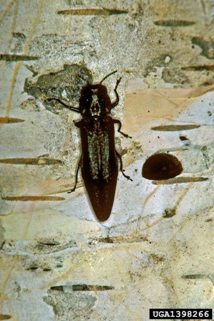
Bronze Birch Borer, with exit hole
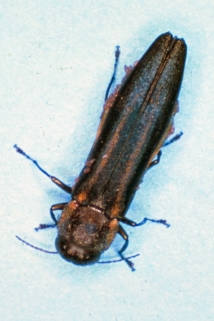
Two Lined Chestnut Borer
Two other buprestids are well-known to those in Connecticut who are concerned about trees. The bronze birch borer is a pest of ornamental birch trees. The two-lined chestnut borer often attacks stressed oak trees, including oaks in the forest.
Why Is EAB a Problem?
EAB is an insect that is not native to North America. It was first found in 2002 in the vicinity of Detroit, MI and Windsor, ON. It had arrived sometime earlier, presumably on wood used in shipping other goods. It is now known to be found in 34 states, 6 provinces and the District of Columbia. As a result, it is now considered as being established in North America. Movement of ash, in particular as firewood, nursery stock, logs and wood packaging materials, has been cited as the most likely means by which EAB has spread so rapidly.
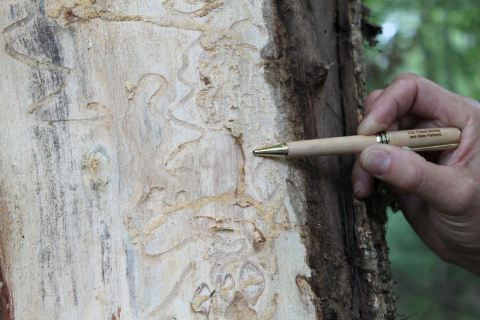
Photo by Dr. Victoria Smith, CT Agricultural Experiment Station
The phloem and cambium layers that the larval EAB feeds on are critical parts of the tree, responsible for the transport of nutrients and for growth. EAB's numbers tend to build up rapidly with infestation by EAB usually leading to the death of the tree affected. Individual trees tend to die within 2-3 years after becoming infested, while stands of trees often succumb within 8 years of the insect entering the stand.
Phloem tissue carries the sugars produced by the leaves throughout the rest of the tree, including down to the roots. As the EAB feeds on the phloem, these other parts of the tree become cut off from their food source. This effectively girdles the tree and so causes its death. The cambial tissue, found between the bark and wood of a tree, is that part of the tree that generates new xylem (wood) and phloem tissue. Because of that, EAB also curtails the ability of the tree to respond to the injury it is inflicting.
Most boring insects attack stressed or injured trees. Healthy trees are better able to resist these insects through such means as the production of inhibiting chemicals. Native North American ash species did not evolve in the presence of EAB and so have not developed the mechanisms to recognize or cope with EAB as a problem. Even healthy native ash trees do not have the ability to effectively resist the onslaught of this invasive, exotic beetle.
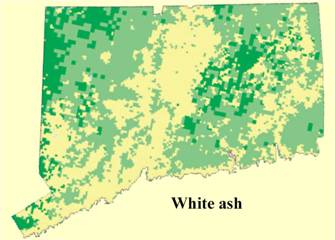
Dark green areas are forested with up to a 19% ash component, light green areas have an ash component of less than 5%.
From the Forests of Connecticut (USFS Resource Bulletin NE-160)
In terms of the number of stems, ash trees make up less than 3% of the trees in the Connecticut forest. Most ash trees in Connecticut are white ash. Prior to EAB, ash in Connecticut had already been seriously declining for several decades. This was due, in part, to a disease called ash yellows. Now that EAB is here, one concern is that the population of ash in the state will be so reduced that it might not be able to recover.
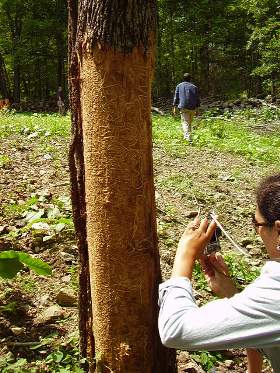
Photo by Kevin Grady, CT DEEP Division of Forestry
The loss of ash trees from the forest, like the loss of any specific kind of tree, would lead to rippling effects on other organisms living in the woods. Butterflies and moths from nearly 30 different families live on ash trees. Seeds of ash are eaten by wood duck, bob white, purple finch, pine grosbeak and fox squirrels. According to the US Forest Service, the elm/ash/red maple forest type is the third most common forest type in the state. While not all stands of this forest type contain ash, most do. Foresters report that, as ash is being lost in a forest stand, undesirable invasive plants are often quick to fill the gap created.
The wood of the white ash is prized due to its combination of strength and flexibility. Uses such as shovel handles and baseball bats take advantage of these properties. It is also used in electric guitar bodies, due to its workability. According to stumpage price reports, ash has a consistent if not high value role to play in Connecticut's timber markets.
Ash is also a modest component of the urban forest. In the northeast, green ash is not the staple street tree that it is in other parts of the country. Ash, however, is not at all unusual along Connecticut's streets and in residential backyards.
Signs and Symptoms of EAB
The first symptom that an ash tree is infested with EAB is often thinning and dieback in the tree's upper canopy. This is because EAB infests the top of the tree first. However, there can be many causes for thinning and dieback in the crown of an ash tree; that symptom alone cannot be considered as diagnostic.
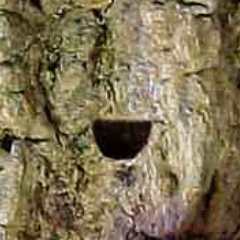
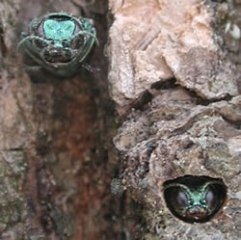
A definite sign of the EAB is the presence of a D-shaped exit hole in the bark of an ash tree. This hole is left by the emerging adult, as it chews its way out of the tree. There are several other borers that attack ash. None of them produces that same D-shaped hole. On other trees, other buprestids, such as the bronze birch borer and the two-lined chestnut borer, do produce D-shaped exit holes. These insects are not found in ash trees. The combination of a D-shaped exit hole and an ash tree is unique to EAB, and a sure indication that the insect is present.
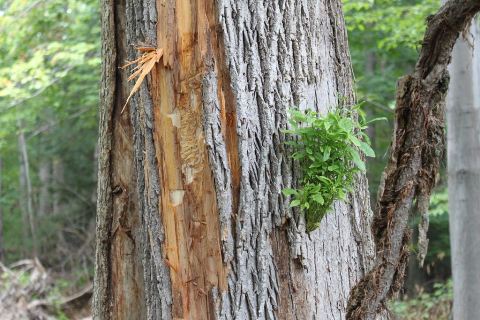
Photo by Dr. Victoria Smith, CT Agricultural Experiment Station
EAB exit holes can, however, be very difficult to see. There are other indicators that are more prominent. When ash trees are seriously infested, often the entire upper crown of the tree will be dead. In an effort to survive, these trees may be sending up numerous shoots from the lower part of the trunk or the root flare. In such heavily infested trees, one can scrape back the bark to reveal the S-shaped tunnels characteristic of the burrowing EAB larvae. With so many larvae active in the tree, woodpeckers will also likely be stripping the outer bark off in patches and pecking holes in the bark to find EAB grubs to feed on. These indicators of woodpecker activity on ash trees is often the giveaway that an ash tree is heavily infested.
Efforts to Detect EAB
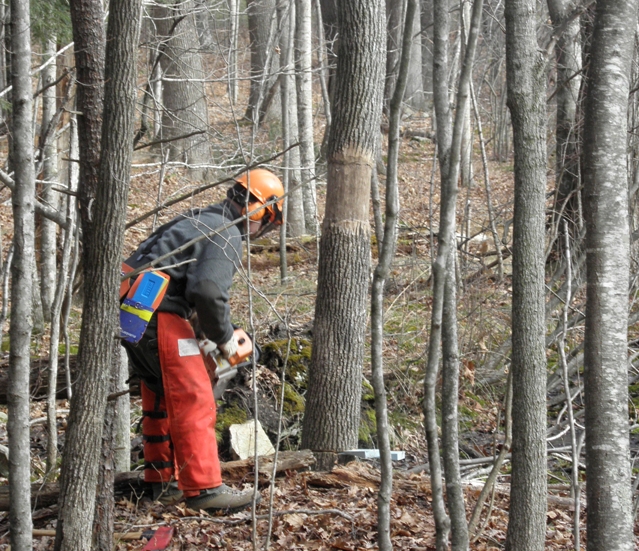
A girdled "trap tree" being felled.
Photo by Chris Donnelly
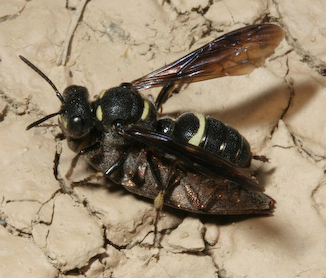
Cerceris fumipennis with prey (not an EAB) .
Photo courtesy of www.cerceris.info
Aside from direct observations, there are two main techniques being employed in the search for EAB. These are:
- trap trees
- biosurveillance
Trap trees are created by the girdling of live ash trees so that the tree becomes highly stressed. The tree is girdled through the removal, down to the wood, of a strip of bark around the lower part of the tree's trunk. As a consequence of being stressed, these trees send out chemical signals that draw in boring insects seeking to feed on and breed in the weakened tree. After several months, these traps trees are cut down and thoroughly inspected for the presence of EAB.
"Biosurveillance" takes advantage of the fact that a native, solitary, non-stinging wasp, Cerceris fumipennis, hunts for buprestids of all types and brings them back to their nesting hole to provide food for their young. "Wasp watchers" catch the wasp as it returns to its nest and take its prey from it, to determine if the wasps are bringing any EAB back from its foraging.
It should be noted that none of these methods will draw EAB into an area where it is not already present. The use of traps does not contribute to an area becoming infested.
What Is Happening Now that EAB Is Found in Connecticut?
In 2012, Connecticut became the 16th state known to have EAB within its borders. As of January 2021 EAB is known to be in 34 states, 6 Canadian provinces and the District of Columbia. Because EAB is already considered as established in North America, eradication is no longer a goal. Instead, focus is on slowing or preventing the spread of the insect into new areas while managing and reducing its numbers in places where it is already found.
Efforts to slow EAB's spread can have very real, positive benefits. This approach buys time until a more effective response to the insect can be found. Investigations continue into forestry techniques, biological control and methods of chemical control. At the same time, there is the potential that natural controls may emerge. Examples of potential natural controls include a genetic response on the part of ash trees or the emergence of already occurring diseases or predators that can provide a check on EAB.
This stands in sharp contrast to the approach being used for the Asian longhorned beetle (ALB). In that case, eradication of the insect in North America is the goal. Due to the behavior of ALB, the potential for complete removal of the insect is very good, and so the effort is aggressive.
Connecticut is seeking to help slow the spread by:
- A quarantine to keep any infested ash materials from leaving Connecticut and going to an area that does not yet have EAB. Specifically, ash logs, hardwood firewood, yard waste and ash nursery stock are all focus of concerns.
- A ban on the importation of firewood into Connecticut through New York or Massachusetts - unless it is properly certified that it has not come from an area already infested.
What Should I Be Doing?
For people in the State of Connecticut, the three most important ways in which an individual can help in this effort is:
- Know what an ash looks like and keep a close eye on those ash trees that you are responsible for, that are in your neighborhood or that you see on a regular basis;
- Act quickly to report any ash trees that are declining and may pose a danger to people or structures; and
- Be especially careful when moving any firewood or young trees.
The use of firewood that has been obtained locally is very important in the effort to prevent further spread of the EAB and other invasive insects. These insects "hitchhike" readily on firewood, which can then sit in a backyard for a year or more, giving ample time for the insect to emerge.
Public trees, such as those along streets and in parks, are usually under the care and control of the municipal tree warden. If you have concerns about these trees, contact your local tree warden.
Trees along state highways are under the control of the State Department of Transportation.
Private trees are the responsibility of the property owner. Owners of ash trees are encouraged to become informed by contacting an arborist and by using such resources as those of the CT Agricultural Experiment Station and DEEP.
Other Sources of Information
EAB Cost Calculator Presentation (presented at the 2014 CT Conference on Natural Resources)
USDA Emerald Ash Borer Program Manual
CT Agricultural Experiment Station EAB Page
The Use of Wood from Urban and Municipal Trees
Background Paper on Potential EAB Costs and Risks to Municipalities
Resources for Spreading the Word
The Impact of EAB - A Case Study from Bristol
Quick Reference Guide to Emerald Ash Borer
Content last updated July 2025.

